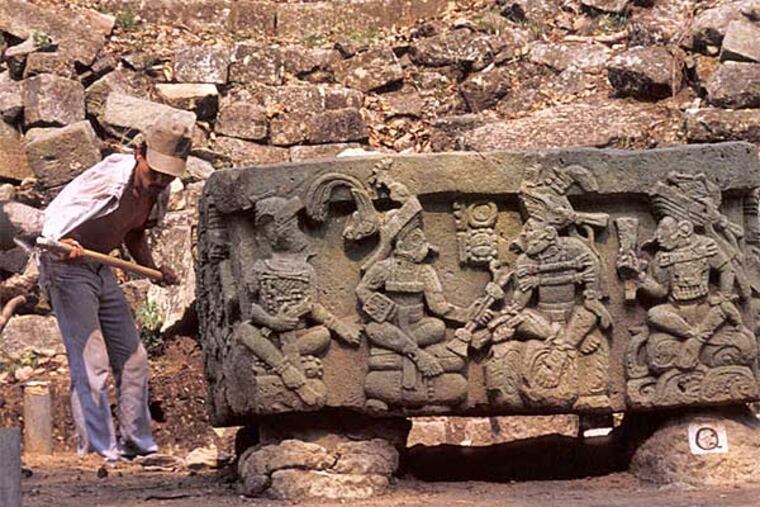'Maya: 2012 Lords of Time' University of Pennsylvania Museum of Archaeology and Anthropology explores ancient civilization
THE WORLD will soon come to an end. Everybody knows that by now. The Mayans predicted the coming cataclysm more than a thousand years ago: Dec. 21, 2012, or, at the latest, Dec. 23. It is strange, then, that "Maya: 2012 Lords of Time," the exhibit at the University of Pennsylvania Museum of Archaeology and Anthropology, runs through Jan. 13.

THE WORLD will soon come to an end. Everybody knows that by now. The Mayans predicted the coming cataclysm more than a thousand years ago: Dec. 21, 2012, or, at the latest, Dec. 23. It is strange, then, that "Maya: 2012 Lords of Time," the exhibit at the University of Pennsylvania Museum of Archaeology and Anthropology, runs through Jan. 13.
Clearly, a major scheduling error has occurred.
The Maya were an ancient civilization that flourished in what is now Central America and southern Mexico. During their heyday, the Mayans developed sophisticated calendars used mostly to keep track of sacred days and to mark the beginnings and ends of cyclical periods. In one of their calendar systems, known as the Long Count, they tracked cycles of time far into the future. Dec. 21, 2012, marks the end of one of these long cycles. The Mayan Long Count resets to 13.0.0.0.0 on that date.
Speculation about the importance of the date 13.0.0.0.0 can be traced to a Mayan monument with phrases on it that scholars have translated as: "the end of the 13th b'ahktun which we will see in the year 2012"; "it will happen"; and "[he] will descend." From this, the legend of Maya 2012 was born.
Yet, the truth behind this prediction is not as exciting as the rumor. The date 13.0.0.0.0 does not represent the end of anything more than a long cycle. For Mayan civilization, December 2012 would be a time for special festivals and rituals, a preparation for a new year and the start of a new long cycle.
Think of it as their New Year's Eve 1999.
The Penn Museum exhibit sets out to debunk the 2012 myth, but it also takes advantage of curiosity over Mayan end-of-the-world prophesies to offer the public a deeper look into Mayan civilization. The exhibit is thus something of a bait-and-switch: Come for the end of the world, stay to learn more about the Mayan alphabet.
As curator Loa Traxler explained in an email, "This exhibit offers a rare opportunity to attract new audiences to the study of American societies - past and present - by delivering a fact-based but visually dynamic and engaging exhibition, interpreting a fascinating American story."
The bait-and-switch is successful because Mayan studies have progressed dramatically in recent decades. Scholars have finally cracked the code for Mayan script, and many new archaeological sites have been uncovered in Central America. The Penn exhibit reveals this new material through a mix of contemporary technology - like a media station that allows you to translate your own name into ancient Mayan - with traditional displays of artifacts like jewelry and pottery.
What comes through clearly is that we are beginning to understand the Mayans - the secrets of a lost civilization are being revealed.
The secrets, however, are not the stuff of fantasy. "Lords of Time" shows that getting to know the Mayans means getting in touch with much that was mundane in their everyday existence.
Many of the stories hidden in Mayan glyphs, once revealed, are bureaucratic and verge on boring. Mayans were obsessed with royal lineage and with tracking the deeds of various rulers. Their language is coded with references to Mayan deities and Mayan history. Special days on the Mayan calendar have significance only if you believed in the Mayan gods and celebrated the Mayan festivals.
The Mayans were not interested in the date 13.0.0.0.0, for instance, because of what it would mean for our contemporary world, a world they never could have imagined, but because it gave significance to events in their own time.
The real secret that the Mayans have handed down to us is not that time will end on this or that date, but that time is relative. Even for the Mayans, the act of counting time changed as Mayan civilization changed.
Later Mayan civilization abandoned the Long Count calendar and focused on calendars that counted shorter periods. It's as if they knew that there was no longer any reason to imagine time and history on such a grand scale. Perhaps it was tacit acknowledgment that their own era was coming to an end, that their great cities would be swallowed up by the jungles and forgotten for many centuries.
As the people of another collapsed civilization once put it: sic transit gloria - thus passes the glory of the world.